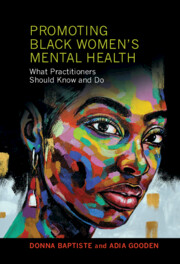Book contents
- Promoting Black Women’s Mental Health
- Promoting Black Women’s Mental Health
- Copyright page
- Contents
- Figures
- Tables
- Contributors
- Introduction
- Part I Black Women in Context
- Part II Therapy Contexts
- Part III Core Themes in Black Women’s Stress and Distress
- 8 Strong Black Woman Persona: Mental Health Impacts
- 9 Shifting in Black Women: Clinical Implications
- 10 Black Women’s Mothering and Caregiving
- 11 Black Women’s Romantic and Intimate Relationships
- 12 Appearance Prejudice and Discrimination against Black Women
- Part IV Helping Black Women Recover and Thrive
- Appendix
- Index
- References
12 - Appearance Prejudice and Discrimination against Black Women
from Part III - Core Themes in Black Women’s Stress and Distress
Published online by Cambridge University Press: 22 June 2023
- Promoting Black Women’s Mental Health
- Promoting Black Women’s Mental Health
- Copyright page
- Contents
- Figures
- Tables
- Contributors
- Introduction
- Part I Black Women in Context
- Part II Therapy Contexts
- Part III Core Themes in Black Women’s Stress and Distress
- 8 Strong Black Woman Persona: Mental Health Impacts
- 9 Shifting in Black Women: Clinical Implications
- 10 Black Women’s Mothering and Caregiving
- 11 Black Women’s Romantic and Intimate Relationships
- 12 Appearance Prejudice and Discrimination against Black Women
- Part IV Helping Black Women Recover and Thrive
- Appendix
- Index
- References
Summary
Appearance Prejudice and Discrimination against Black Women discusses Black women’s substantive experiences of discrimination based on their appearance. Black women experience biases around body features, skin color, hair, personal grooming choices, and other appearance-related variables. Black women also receive constant messages about how they do not meet mainstream beauty standards. These messages may cause women to internalize negative self-images. We offer therapists strategies to support Black women to deconstruct beauty stereotypes and foster cultural beauty ideals to help manage and reject societal invalidations.
- Type
- Chapter
- Information
- Promoting Black Women's Mental HealthWhat Practitioners Should Know and Do, pp. 288 - 308Publisher: Cambridge University PressPrint publication year: 2023



